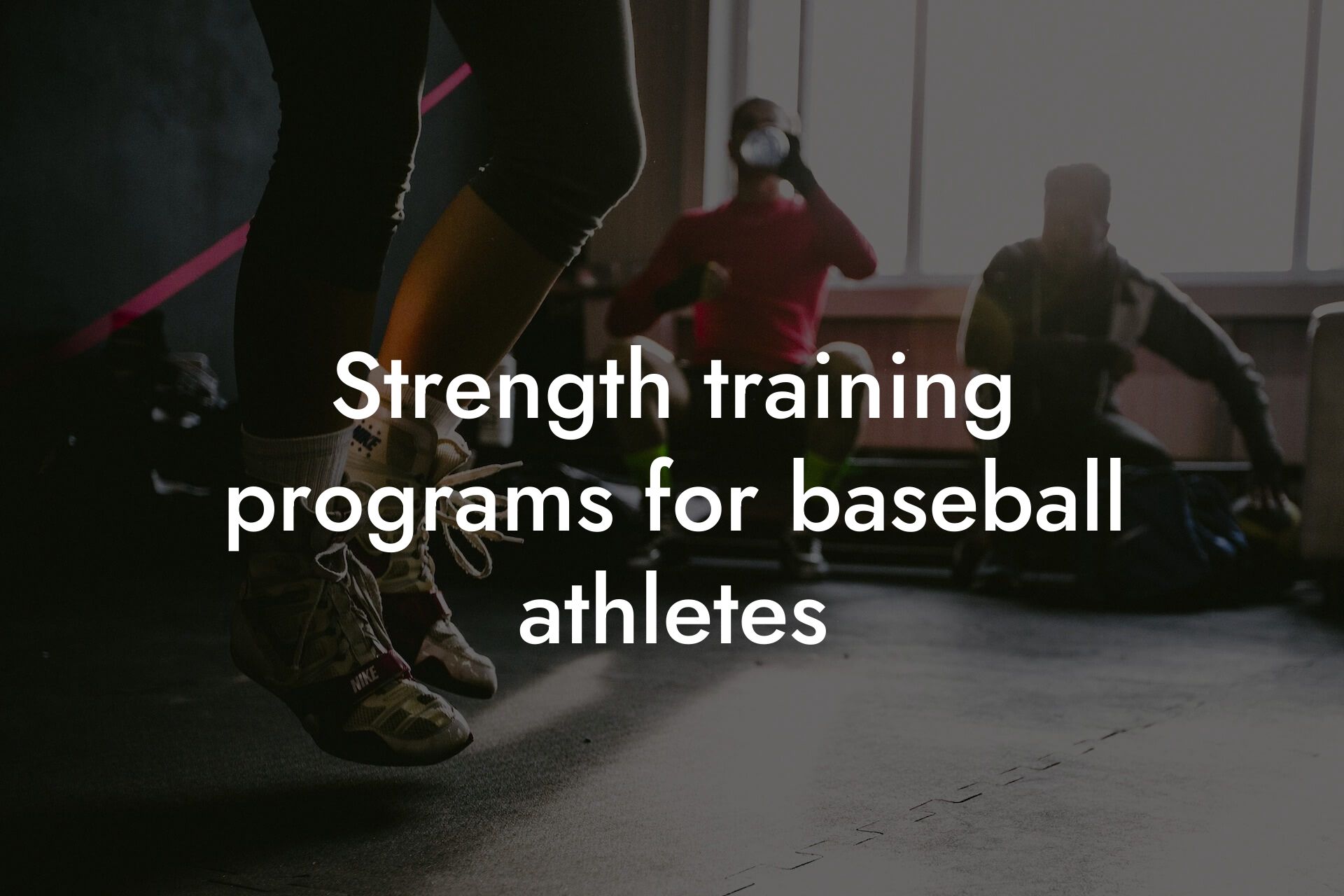As a baseball player, the off-season is a critical period for improving your skills, building strength, and enhancing overall performance. A well-structured off-season conditioning program can make all the difference in your game, helping you to stay ahead of the competition and achieve your goals. In this article, we'll provide a comprehensive guide to off-season conditioning for baseball players, covering the essential components, exercises, and tips to help you dominate on the field.
Table of Contents
- Why Off-Season Conditioning Matters
- Components of an Effective Off-Season Conditioning Program
- Essential Exercises for Baseball Players
- Incorporating Plyometrics and Agility Training
- Building Endurance and Cardiovascular Fitness
- Incorporating Active Recovery and Flexibility Training
- Sample Off-Season Conditioning Program
- Frequently Asked Questions
Why Off-Season Conditioning Matters
The off-season is a time for baseball players to focus on building their strength, power, speed, and endurance. A well-designed conditioning program can help to:
- Improve overall athleticism and performance
- Increase strength and power
- Enhance speed and agility
- Boost endurance and stamina
- Reduce the risk of injury
- Gain a competitive edge over opponents
Components of an Effective Off-Season Conditioning Program
A comprehensive off-season conditioning program should include a combination of the following components:
- Strength training: Building strength in the muscles used in baseball, such as the legs, hips, and core
- Power training: Developing explosive power to improve bat speed, throwing velocity, and acceleration
- Speed and agility training: Enhancing speed, quickness, and agility to improve fielding and base running
- Endurance training: Building cardiovascular endurance to maintain energy levels throughout the game
- Flexibility and mobility training: Improving range of motion and reducing the risk of injury
- Active recovery: Incorporating low-intensity activities, such as yoga or cycling, to aid in recovery and reduce muscle soreness
Essential Exercises for Baseball Players
Here are some essential exercises that should be included in an off-season conditioning program for baseball players:
- Squats: Building strength and power in the legs
- Deadlifts: Developing strength and power in the legs, hips, and back
- Lunges: Improving strength, balance, and coordination
- Box jumps: Enhancing explosive power and speed
- Medicine ball throws: Developing rotational power and strength
- Planks: Improving core strength and stability
- Agility drills: Enhancing speed, quickness, and agility
Incorporating Plyometrics and Agility Training
Plyometric exercises, such as jump squats and box jumps, are essential for building explosive power and speed. Agility drills, such as cone drills and ladder drills, can help to improve quickness, reaction time, and change of direction. These exercises should be incorporated into the conditioning program 2-3 times per week.
Building Endurance and Cardiovascular Fitness
Endurance training is critical for baseball players, as it helps to build cardiovascular fitness and maintain energy levels throughout the game. Incorporate cardio exercises, such as jogging, cycling, or swimming, into the conditioning program 2-3 times per week. Aim for 20-30 minutes of moderate-intensity cardio per session.
Incorporating Active Recovery and Flexibility Training
Active recovery and flexibility training are essential components of an off-season conditioning program. Incorporate low-intensity activities, such as yoga or cycling, 1-2 times per week to aid in recovery and reduce muscle soreness. Flexibility exercises, such as stretching and foam rolling, can help to improve range of motion and reduce the risk of injury.
Sample Off-Season Conditioning Program
Here's a sample off-season conditioning program for baseball players:
- Monday (strength training): Squats, deadlifts, lunges, and upper body exercises
- Tuesday (power training): Plyometric exercises, such as jump squats and box jumps
- Wednesday (active recovery): Yoga or cycling
- Thursday (speed and agility training): Agility drills, such as cone drills and ladder drills
- Friday (endurance training): Cardio exercises, such as jogging or cycling
- Saturday (strength training): Lower body exercises, such as squats and lunges
- Sunday (active recovery): Yoga or cycling
A well-structured off-season conditioning program is essential for baseball players looking to improve their performance and gain a competitive edge. By incorporating strength training, power training, speed and agility training, endurance training, and active recovery, baseball players can optimize their physical fitness and dominate on the field. Remember to stay committed, stay consistent, and stay focused on your goals.
At Tano Performance Group, we understand the importance of optimal physical fitness for high-earning professionals. Our DEXA machine provides a comprehensive body assessment, giving you the information you need to take your physique to the next level. Contact us today to learn more about our services and how we can help you achieve your goals.
Frequently Asked Questions
What is off-season conditioning for baseball players?
Off-season conditioning for baseball players refers to a structured program of exercises, drills, and activities designed to improve their physical fitness, strength, speed, agility, and overall performance during the period between competitive seasons. This critical phase helps players address weaknesses, recover from injuries, and prepare for the demands of the upcoming season.
Why is off-season conditioning important for baseball players?
Off-season conditioning is crucial for baseball players as it allows them to maintain and improve their physical abilities, reduce the risk of injury, and gain a competitive edge over their opponents. A well-planned off-season program can help players increase their power, speed, and endurance, leading to improved performance on the field.
What are the key components of an off-season conditioning program for baseball players?
A comprehensive off-season conditioning program for baseball players should include a combination of strength training, plyometric exercises, agility drills, speed training, and conditioning exercises. It should also incorporate flexibility and mobility exercises, as well as nutrition and recovery strategies.
How long should an off-season conditioning program last?
The duration of an off-season conditioning program can vary depending on the individual player's needs and goals. Typically, a program can last anywhere from 12 to 20 weeks, with a gradual progression from general preparation to specific preparation and finally to active competition.
What are the benefits of strength training for baseball players?
Strength training is essential for baseball players as it helps improve their power, speed, and endurance. It also enhances their ability to generate force, accelerate, and decelerate, leading to improved performance in areas such as hitting, pitching, and fielding.
What types of exercises should baseball players include in their strength training program?
A baseball player's strength training program should include a combination of exercises that target their upper body, lower body, and core. Examples of exercises that can be beneficial include squats, deadlifts, bench press, rows, and lunges, as well as plyometric exercises such as box jumps and medicine ball throws.
How often should baseball players strength train during the off-season?
The frequency of strength training during the off-season will depend on the individual player's goals and current fitness level. Generally, a strength training program should be performed 2-3 times per week, with at least one day of rest in between.
What is plyometric training, and how can it benefit baseball players?
Plyometric training, also known as jump training, involves explosive movements that help improve an athlete's power and speed. For baseball players, plyometric training can be beneficial for improving their ability to generate force, accelerate, and decelerate, leading to improved performance in areas such as hitting, pitching, and fielding.
What types of plyometric exercises are beneficial for baseball players?
Examples of plyometric exercises that can be beneficial for baseball players include box jumps, depth jumps, medicine ball throws, and resisted sprints. These exercises can help improve their power, speed, and agility, leading to improved performance on the field.
How can agility drills benefit baseball players?
Agility drills can help baseball players improve their speed, quickness, and change of direction, allowing them to cover more ground on the field and make plays that might otherwise be out of reach. Agility drills can also help improve their reaction time and decision-making skills.
What types of agility drills are beneficial for baseball players?
Examples of agility drills that can be beneficial for baseball players include cone drills, ladder drills, and shuttle runs. These drills can help improve their speed, quickness, and change of direction, leading to improved performance on the field.
How can speed training benefit baseball players?
Speed training can help baseball players improve their acceleration, deceleration, and top-end speed, allowing them to cover more ground on the field and make plays that might otherwise be out of reach. Speed training can also help improve their reaction time and decision-making skills.
What types of speed training exercises are beneficial for baseball players?
Examples of speed training exercises that can be beneficial for baseball players include resisted sprints, short sprints, and hill sprints. These exercises can help improve their acceleration, deceleration, and top-end speed, leading to improved performance on the field.
How can conditioning exercises benefit baseball players?
Conditioning exercises can help baseball players improve their endurance, allowing them to maintain their intensity over the course of a long game or season. Conditioning exercises can also help improve their recovery time, reducing the risk of injury and fatigue.
What types of conditioning exercises are beneficial for baseball players?
Examples of conditioning exercises that can be beneficial for baseball players include pro agility shuttles, beep tests, and high-intensity interval training (HIIT). These exercises can help improve their endurance, leading to improved performance on the field.
How can nutrition play a role in off-season conditioning for baseball players?
Nutrition plays a critical role in off-season conditioning for baseball players, as it helps support their training and recovery. A well-planned nutrition program should include a balanced diet that provides adequate protein, complex carbohydrates, and healthy fats, as well as hydration and supplementation strategies.
How can recovery strategies benefit baseball players during the off-season?
Recovery strategies such as foam rolling, stretching, and self-myofascial release can help baseball players reduce muscle soreness and improve their recovery time during the off-season. These strategies can also help reduce the risk of injury and improve their overall performance.
What are some common mistakes baseball players make during the off-season?
Common mistakes baseball players make during the off-season include not having a structured training program, not allowing for adequate recovery time, and not addressing weaknesses and imbalances. These mistakes can lead to poor performance, injury, and burnout.
How can baseball players stay motivated during the off-season?
Baseball players can stay motivated during the off-season by setting specific, measurable, and achievable goals, finding a training partner or accountability group, and tracking their progress. They can also stay motivated by rewarding themselves for reaching milestones and celebrating their successes.
What are some common myths about off-season conditioning for baseball players?
Common myths about off-season conditioning for baseball players include the idea that strength training will make them slower or less agile, that they should only focus on baseball-specific skills during the off-season, and that they don't need to worry about conditioning until the season starts. These myths can lead to poor performance and injury.
How can baseball players get started with an off-season conditioning program?
Baseball players can get started with an off-season conditioning program by consulting with a qualified coach or trainer, setting specific goals and objectives, and creating a structured training plan. They can also start by incorporating simple exercises and drills into their daily routine, gradually increasing the intensity and complexity as they progress.
What are some resources available to baseball players looking to improve their off-season conditioning?
Resources available to baseball players looking to improve their off-season conditioning include online training programs, coaching and training services, and sports performance facilities. They can also access a wealth of information through books, articles, and online forums.
How can Tano Performance Group help baseball players with their off-season conditioning?
Tano Performance Group offers a range of resources and services to help baseball players improve their off-season conditioning, including personalized coaching and training programs, sports performance facilities, and nutrition and recovery strategies. Our team of experienced coaches and trainers can help baseball players achieve their goals and reach their full potential.
Here are some related articles you might love...
- How DEXA scans can help baseball players optimize performance
- Recovery strategies for baseball athletes
- Strength training programs for baseball athletes
- Reducing body fat for better speed on the bases
- Balancing muscle mass and flexibility in baseball
- The importance of core strength in baseball performance
- The role of body composition in baseball power and endurance
- Nutrition strategies for maintaining muscle during the baseball season
- Bone density and its impact on injury prevention in baseball
Zak Faulkner
Zak Faulkner is a leading authority in the realm of physical health and body composition analysis, with over 15 years of experience helping professionals optimise their fitness and well-being. As one the experts behind Tano Performance Group, Zak has dedicated his career to providing in-depth, science-backed insights that empower clients to elevate their physical performance and overall health.
With extensive knowledge of DEXA technology, Zak specializes in delivering comprehensive body assessments that offer precise data on body fat, muscle mass, bone density, and overall physique. His expertise enables individuals to make informed decisions and achieve their fitness goals with accuracy and confidence. Zak’s approach is rooted in a deep understanding of human physiology, combined with a passion for helping clients unlock their full potential through personalised strategies.
Over the years, Zak has earned a reputation for his commitment to excellence, precision, and client-focused service. His guidance is trusted by top professionals who demand the best when it comes to their health. Whether advising on fitness programs, nutritional strategies, or long-term wellness plans, Zak Faulkner’s insights are a valuable resource for anyone serious about taking their health and fitness to the next level.
At Tano Performance Group, Zak continues to lead our Content Team revolutionising how professionals approach their physical health, offering unparalleled expertise that drives real results.




